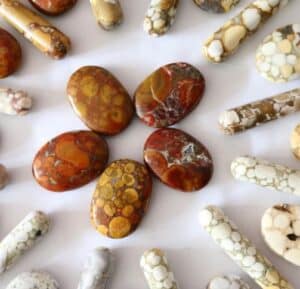King Cobra Jasper, also called Cobra Jasper, is a stunning Orbicular variety that stands out among its peers. Many collectors and rockhounds find it interesting that the beautiful orbs of King Cobra Jasper are created by spherical inclusions of radial aggregates that are actually needle-like accumulations of crystals. Some collectors and sellers claim they have King Cobra Jaspers ranging from the palest whites to rich maroon hues. The wonderfully spaced patterns in reds, oranges, yellows, and browns are eye-catching.

FAQs For King Cobra Jasper
King Cobra Jasper only has one alternative name, which is Cobra Jasper. Aside from the hues listed above, the stones can be sourced in red, orange, and white shades. It registers a hardness of 7 according to the Mohs Hardness Scale, similar to most Jasper varieties that rate a 6.5 to 7.
This Jasper variety offers a trigonal crystal system and produces a white streak when using the streak test. King Cobra Jasper has a vitreous luster, meaning it has a glass-like appearance and reflective properties. For the lapidary artists reading this article, this variety of Jasper takes a pretty good polish but nothing like Imperial Jasper or Condor Agate.
There is currently only one region in the world where King Cobra Jasper is found. Keep reading to find out where.
What Is King Cobra Jasper?
King Cobra Jasper is a form of Orbicular Jasper, which is a distinct variety of Jasper that’s identified by its orb-like spherical markings. The name “King Cobra Jasper” is one given to the stone by people in the crystal and gem trade markets as part of a way to pique interests and gain sales.
Cobra Jasper is used primarily as a decorative stone. Orbicular Jaspers can be bright and colorful but this variety won’t take an extremely high polish. In my opinion, it’s more like a moderate to high polish.
Varieties of Orbicular Jasper can be found in several locations around the globe. Ocean Jasper, which is one of the best-known varieties, is only found in Madagascar, while Poppy Jasper hails from Morgan Hill, Santa Clara County, California. King Cobra Jasper is found in an area in India, and to this day, it’s the only known location.

Where Is King Cobra Jasper Found?
King Cobra Jasper has only been around for about a decade. It was discovered in India in early 2010 and is not commercially available but you can source them from online sellers. These stones are a relatively uncommon variety of Orbicular Jasper and Chalcedony found in the Uttar Pradesh region of Northern India. King Cobra Jasper closely resembles Ocean Jasper, but the differences are also obvious.
How To Identify King Cobra Jasper
Identifying King Cobra Jasper or any variety of Jasper is relatively simple.
The ID process strongly depends on the quality and condition of the specimen. You’ll be using visual inspections to make most of your decisions. As you can see from the images above, you’ll be looking for the orbicular inclusions and the colors for which this stone is known for.
1: Check The Grain Size
Checking the grain size of Jasper is a crucial step. You’ll want to observe fresh, unweathered surfaces of the stone under good lighting conditions. If you can see grains with the naked eye, it is definitely NOT a Jasper. If you clearly see Quartz grains, it’s most likely Sandstone or Quartzite.
Use a hand loupe for magnification. If you can still distinguish the grains, the specimen could be microcrystalline varieties of Quartz, like Tiger’s or Hawk’s Eye. Both of those stones are strongly different from Jasper in color and texture.
Real or genuine Jasper is Cryptocrystalline, so no grains are visible, even with the help of a loupe.
2: Opacity
Unlike various varieties of Chalcedony, such as Carnelian, Agate, Sard, and Chrysocolla, Jasper is the only opaque stone. This means it doesn’t transmit light.
Place a flashlight on the back of the stone and see if the light shines through. This is a simple diaphaneity test. Even if a minute amount of light passes through the stone, it is disqualified as a Jasper. Even in thin slices of material, Jasper should be completely opaque.
3: Hardness
Most natural substituents contain the same or a very similar hardness. Fakes made of glass or plastic are easily distinguished by conducting a hardness test. Plastic imitations are easily scratched by a nail or knife, while true Jaspers are not. Glass can be scratched by Quartz crystals. Additionally, fakes made of glass are likely to be translucent, allowing some amount of light to pass.

King Cobra Jasper Value
While King Cobra Jasper isn’t as highly valued as Imperial Jasper, it is still on the expensive side. The larger the piece and the more detail present, the higher the price and value will be. Small pendants usually cost $50 to $125 and up. While slabs can be more affordable because they are raw or rough.
- Identify Enstatite - March 12, 2024
- Identify Cerussite - March 3, 2024
- Identify Bytownite - February 18, 2024
